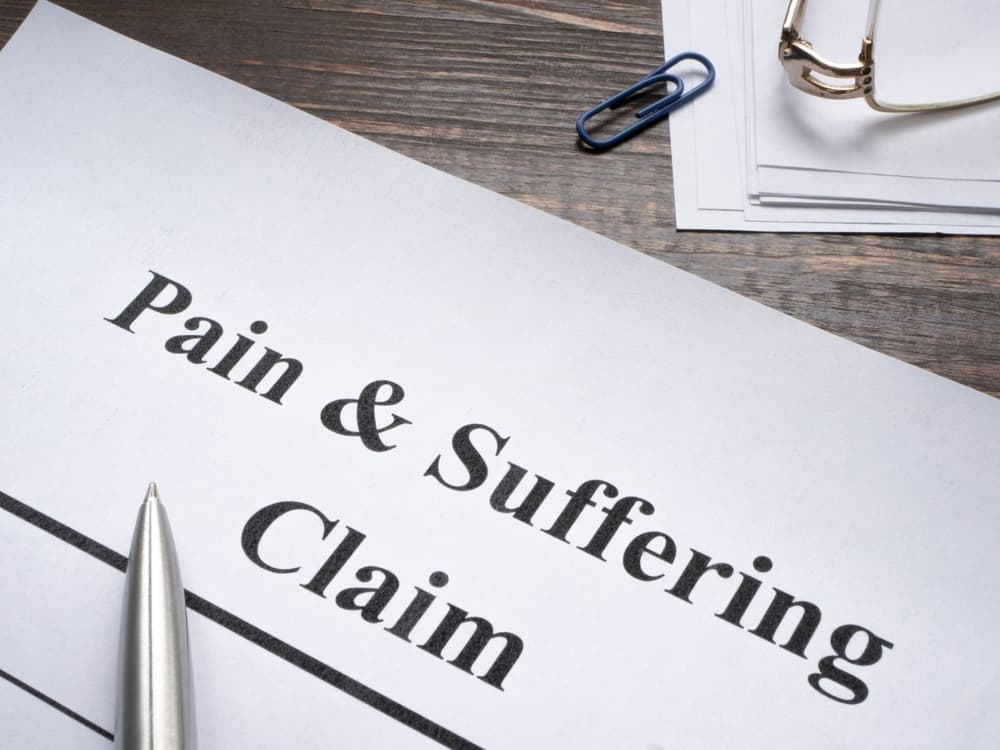When you suffer a traumatic brain injury (TBI), you likely need significant relief. With mounting medical expenses adding to your burden and a full recovery nowhere in sight, you may also have to deal with pain and suffering stemming from the accident. But when you file a claim for compensation, there may be no one around to explain what pain and suffering are and how much you can get for this category of damages if you suffered a TBI.
A skilled personal injury lawyer in Marietta can explain if you are eligible for pain and suffering and how to determine and prove these damages.
What Is Pain and Suffering in a Personal Injury Case?

Each year, about 60 million Americans seek medical treatment for non-fatal preventable injuries; some of them are for traumatic brain injuries. For many of these people, TBIs are accompanied by pain and suffering, which is compensable under the law.
Pain and suffering refer to the physical and emotional distress caused by an injury. This is not just about the immediate pain felt at the time of the accident but includes ongoing discomfort, limitations, and emotional anguish caused by the injury. In a legal context, pain and suffering are often categorized into two main types:
- Physical pain and suffering encompass the pain and discomfort that result directly from the physical injuries. This can include ongoing pain, future medical treatments, and any long-term disabilities or limitations.
- Mental pain and suffering, on the other hand, cover the psychological impact of the injury. This can range from emotional distress, anxiety, depression, and loss of enjoyment of life to more severe mental health issues triggered by the accident.
In the eyes of the law, these damages are subjective and often require detailed documentation and expert testimony to quantify adequately. However, they are a crucial part of the compensation as they acknowledge the profound impact an injury can have on one’s quality of life. We will get to the methods of calculating pain and suffering damages later.
What Is Included in Pain and Suffering?
Pain and suffering damages encompass a wide range of experiences and consequences resulting from an injury. While each case is unique, several common factors are considered when calculating these damages:
- Physical pain. Including any immediate or ongoing pain related to the injury. It also covers any future pain that doctors anticipate you will experience due to the injury.
- Emotional distress. Anxiety, depression, post-traumatic stress disorder (PTSD), and other emotional and psychological impacts are included in this category. The emotional toll of dealing with the injury, treatment, and the aftermath can be burdensome and long-lasting.
- Loss of enjoyment of life. If your traumatic brain injury prevents you from enjoying activities that were once a significant part of your life, such as hobbies, physical exercise, playing with your kids, or social activities, these losses are taken into account when calculating pain and suffering.
- Loss of consortium. This refers to the impact of the injury on your relationship with your spouse or family. Serious TBIs can strain relationships, affecting companionship, affection, and sexual relations, among other aspects.
- Disfigurement and disability. Permanent scars, disfigurements, or disabilities that alter your appearance or ability to perform daily tasks are also included under pain and suffering. These changes can have profound emotional and psychological impacts that merit compensation.
It’s essential to document these experiences thoroughly. Keeping a pain journal, seeking regular medical and mental health treatment, and collecting testimonies from friends, family, and employers can help substantiate your claim for pain and suffering.
Signs You May Be Eligible to Recover Pain and Suffering Damages
Determining eligibility for pain and suffering damages can be challenging, as these damages are subjective and vary from one individual to another. However, there are five key indicators that you may be entitled to recover these damages:

- Severe or life-altering physical injuries. If you have sustained life-changing physical injuries that cause substantial pain or require ongoing medical treatment, you likely qualify for pain and suffering damages. The more serious the TBI, the more profound its impact on your quality of life and daily activities.
- Documented emotional distress. If you have experienced emotional distress as a result of your injury and you have evidence to prove it, you may be eligible for compensation. Medical records from mental health professionals can substantiate these claims.
- Permanent disfigurement or disability. Traumatic brain injuries that result in permanent disfigurement or disability often lead to lifelong physical and emotional pain. These lasting impacts are often seen as strong grounds for pain and suffering damages.
- Loss of quality of life. If your injury has drastically reduced your ability to enjoy life and participate in activities you once enjoyed, this loss can be factored into pain and suffering damages. Testimonies from those who knew you before and after the injury can help illustrate this change.
- Impact on personal relationships. If your injury has negatively affected your relationship with your spouse or family, this can be a sign that you are eligible to recover pain and suffering damages. Statements from affected loved ones can support this aspect of your case.
Not sure if the TBI you sustained qualifies for pain and suffering? Let a personal injury attorney review the facts of your case and determine if you can increase the value of your claim for compensation by including “pain and suffering” in the claim.
How Are Pain and Suffering Damages Calculated?
Unlike economic damages, which refer to quantifiable losses such as medical bills and lost income, pain and suffering damages are more subjective and can vary significantly from one person to another. Lawyers, insurance companies, and judges use two common methods to calculate pain and suffering damages.
The Per Diem Method
The per diem method calculates pain and suffering based on a daily rate, multiplied by the number of days the injured victim’s pain and suffering is expected to last. The term “per diem” is Latin for “per day.” This method operates under the principle that the victim should receive a specific monetary amount for each day they experience pain and suffering.
- How it works: To apply the per diem method, the first step is to determine an appropriate daily rate. This rate can be based on various factors, including the victim’s daily earnings, the severity of the injury, and the degree of pain and discomfort experienced every day. Once the daily rate is set, it is multiplied by the number of days the victim is expected to suffer.
- Example: Consider a personal injury case where a victim suffers a broken leg due to a car accident. Suppose it takes about 90 days for the leg to heal completely. Based on their earnings and discomfort, the victim’s daily rate is $150. Using the per diem method, 90 days multiplied by $150 equals $13,500.
The Multiplier Method
The multiplier method is another common way to calculate damage caused by pain and suffering. With this method, the total economic damages (such as medical bills and lost income) are multiplied by a certain factor (the so-called “multiplier”), which can range anywhere from 1.5 to 5 based on the severity of the injury, the duration of recovery, and other relevant factors.
- How it works: To use the multiplier method, you need to calculate the total economic damages you have incurred and choose an appropriate multiplier based on the specifics of the case. Then, multiply the total economic damages by this multiplier to determine the amount of pain and suffering damages.
- Example: Let’s take another example where a victim incurs $40,000 (the average cost of an “evident” injury from a motor vehicle accident) in medical expenses and lost income due to a severe back injury from a car accident. Given the severity of the injury and a prolonged recovery period, a multiplier of three is deemed appropriate. Using the multiplier method, $40,000 multiplied by three equals $120,000.
Evidence That Can Help You Prove Pain and Suffering
Given the subjective nature of pain and suffering, the evidence you present to show how the accident has affected you on a physical, emotional, psychological, and mental level plays a fundamental role.
Documented Evidence of Your Diagnosis and All Medical Treatment
Without medical records, proving pain and suffering in a personal injury case is nearly impossible. These documents provide an objective account of your traumatic brain injury, diagnoses, and the treatment you have received. Detailed records from your doctors, hospitals, and therapists outline the extent of your physical pain and the medical interventions required to address your condition. Make sure to include:
- Initial diagnosis and follow-up reports
- Prescription medications and dosages
- Records of surgeries or other medical procedures
- Physical therapy and rehabilitation sessions
- Any specialist consultations
These documents collectively paint a full picture of your medical journey, making it difficult for opposing parties to dispute the legitimacy of your claims.
Proof of Loss of Enjoyment
Pain and suffering often extend beyond physical pain, including a loss of enjoyment in everyday activities. This element of damage captures the impact of your TBI on your quality of life. To demonstrate this loss, consider the following types of evidence:
- Personal journals or diaries detailing your pre-injury lifestyle compared to your current state
- Testimonials from friends, family, or colleagues about changes in your ability to participate in hobbies or social activities
- Documentation of missed events such as vacations, sports, or family gatherings
Highlighting how your injuries have diminished your ability to enjoy life can powerfully convey the depth of your suffering to a judge or jury.
Photo and Video Documentation of Your Pain
Visual evidence can be incredibly persuasive in showing the reality of your pain and suffering. Photographs and videos can capture your physical condition and the visible impact of your traumatic brain injury over time. Important visual documentation may include:
- Photos of injuries immediately after the incident and during the healing process
- Videos demonstrating your physical limitations or mobility issues
- Recordings of therapy sessions or daily routines impacted by your injuries
These visuals provide an unfiltered look at the physical toll of your injuries, complementing written and verbal testimony.
Testimony from Your Loved Ones
The people closest to you can offer a unique perspective on how your TBI has affected you emotionally and physically. Testimonies from loved ones can humanize your pain and suffering, making it relatable and understandable. They can discuss:
- Observations of your pain and struggles in daily activities
- Changes in your mood or behavior since the injury
- The emotional impact your suffering has had on your relationships
Such personal accounts add depth to your claim, providing a heartfelt narrative that supports your case.
Testimony from Medical Experts
Expert testimony can fortify your claims by providing professional insights into your condition. Medical experts can explain the severity and expected duration of your pain and suffering, offering a credible and authoritative viewpoint. Consider securing testimony from:
- Your treating physicians and surgeons
- Pain management specialists
- Psychologists or psychiatrists
These professionals can correlate your symptoms with your overall prognosis, helping to justify the extent of the damages you are seeking.
Personal Records of Your Emotional Distress and Anguish
Maintaining a detailed record of your emotional experiences following your injury can be vital in proving pain and suffering. This can include:
- Journals documenting your daily emotional state, challenges, and progress
- Notes on any therapy or counseling sessions attended
- Records of medications prescribed for mental health issues related to your injury
These personal records serve as a firsthand account of your struggles with emotional distress, highlighting the ongoing and often invisible aspects of pain and suffering.
How Can a Personal Injury Lawyer Help You Recover Fair Compensation for Pain and Suffering?
Recovering fair compensation for pain and suffering requires a strategic, evidence-based approach. A personal injury attorney can bring their experience, resources, and advocacy to your side, ensuring you receive the compensation you deserve. Here are some of the ways an attorney can help:
- Evaluation of your case. A lawyer will thoroughly assess your case to understand the extent of your physical and emotional suffering. This involves reviewing medical records, consulting healthcare providers, and speaking with family and friends.
- Gathering evidence. To substantiate your claim for pain and suffering, an attorney will collect various forms of evidence, such as medical documentation, expert testimony, and personal journals.
- Calculating fair compensation. Your attorney will use various methods to calculate your pain and suffering and determine the maximum amount possible to fully compensate you for what you are going through.
- Negotiating with insurance companies. Insurance companies often aim to minimize payouts, especially when it comes to pain and suffering damages. Your personal injury lawyer will strive to present compelling evidence of your pain and suffering, negotiate aggressively to secure a fair settlement, and counter lowball offers with strong arguments backed by evidence.
- Representing you in court. If the insurance company refuses to pay a reasonable amount, it may be necessary to go to court. While 97 percent of all tort claims are settled out of court, it will give you more confidence if you are represented by a lawyer with litigation experience.
Last but not least, your personal injury lawyer can provide you with the emotional support you need during this difficult time. Having legal counsel can alleviate the stress associated with legal proceedings, which can have a positive impact on your recovery and overall well-being.
